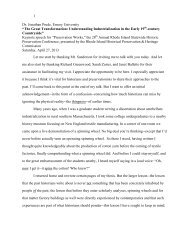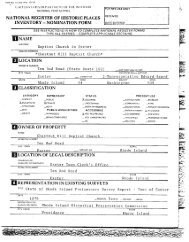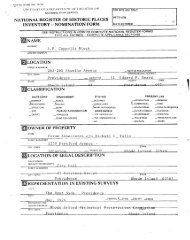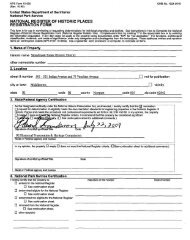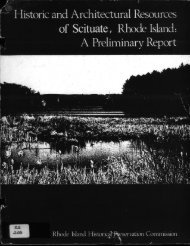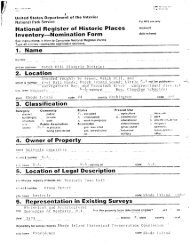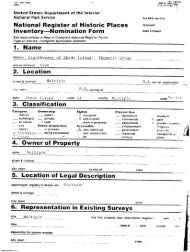National Park Service - Rhode Island Historical Preservation ...
National Park Service - Rhode Island Historical Preservation ...
National Park Service - Rhode Island Historical Preservation ...
You also want an ePaper? Increase the reach of your titles
YUMPU automatically turns print PDFs into web optimized ePapers that Google loves.
NPS Form 10-900-i<br />
3-82<br />
-<br />
-<br />
-<br />
0MB Nt 10240018<br />
En,- 10-31-U<br />
United States Department of the Interior -<br />
<strong>National</strong> <strong>Park</strong> <strong>Service</strong><br />
<strong>National</strong> Register of HistOric Places<br />
Inventory-Nomination Foim -<br />
Continuation sheet 4 9 Item number 8<br />
Page 5<br />
dinners and soc-ials; and a well-staffed gym provided exercise and<br />
recreation. The Hazards erected at least four Peace Dale -<br />
schools, including Stepping Stone Kindergarten founded in 1891 by<br />
Mrs. Rowland Hazard II and sustained by her daughter, Caroline<br />
Hazard, until donated to the Town in 1945.<br />
Throughout the nineteenth century, labor relations in Peace<br />
Dale were a model of cooperation and cordiality, a situation<br />
promoted by the practice of sending each worker a yearly circular<br />
reporting on the status of business, prospects for the future,<br />
and topics of immediate concern to employer and employees. After<br />
the death-of Rowland Hazard II, the closeness of labor-management<br />
relations diminished. There was a minor strike the first at<br />
Peace Dale in 1903, followed in 1906 by a major. walkout which<br />
threatened to shut down the mills. A fourth generation of Peace -<br />
Dale Hazards now ran the mills. They worked determinedly and<br />
effectively to counter the strike. The workers who struck were<br />
dismissed and immediately replaced by strikebreakers. This<br />
uncharacteristic episode in Peace Dale’s industrial and social<br />
history is memorialized by a very unprepossessing row of attached -<br />
mill- houses at 3-15 Green Street #27 throw up hastily in March,<br />
1906, to house the "scabs." Despite this conflict, -the Hazard<br />
family quickly resumed its long-established pattern of local -<br />
philanthropy, beginning construction of the Neighborhood Guild<br />
headquarters and creating the village green in 1907. With the<br />
death of Rowland G. Hazard II in 1918, however, the family<br />
decided to sell the mills. From a business viewpoint it was, a<br />
wise decision, and Hazard patronage in the village continued on a<br />
reduced but still very significant level right up to the Second<br />
World War. The new owner was the M.T. Stevens Company of North<br />
Andover, Massachusetts. No longer, however, was there a close<br />
identification between the mills’ proprietor and the village. -<br />
After an enormous increase in production at Peace Dale during the<br />
Second World War, the Stevens Company shut down the plant in<br />
1948. in 1946 Lily Pads, the J. N. Hazard place, became a<br />
Catholic school and retreat. In 1948 two other Hazard dwellings,<br />
Holly House and Oakwoods, were torn down, the land becoming a<br />
residential subdivision. That same year Caroline Hazard’s<br />
residence, the Scallop Shell, was converted into a nursing home.<br />
The era of Hazard domination had come to an end.<br />
Demolition of Holly House, Oakwoods, and Scallop Shell were<br />
the only major losses to Peace Dale’s historic fabric. And<br />
- because all three big houses were secluded within extensive<br />
grounds, their absence, visually speaking, has had little impact.<br />
Peace Dale "reads" as it would have in the early twentieth







